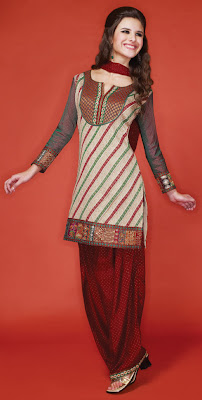Salwar Kameez Online Usa Biography
Source (google.com.pk)Shalwar are gathered at the waist and held up by a drawstring or an elastic band. The pants can be wide and baggy or more narrow, and even made of fabric cut on the bias.
The kameez is usually cut straight and flat; older kameez use traditional cuts, as shown in the illustration above. Modern kameez are more likely to have European-inspired set-in sleeves. The tailor's taste and skill are usually displayed, not in the overall cut, but in the shape of the neckline and the decoration of the kameez. Modern versions of the feminine kameez can be much less modest than traditional versions. The kameez may be cut with a deep neckline, sewn in diaphanous fabrics, or styled in cap-sleeve or sleeveless designs. The kameez side seams may be split up to the thigh or even the waistline, and it may be worn with the salwar slung low on the hips. When a woman wears a semi-transparent kameez (mostly as a party dress), she wears a choli or a cropped camisole underneath it.
When women wear the salwar kameez, they usually wear a long scarf or shawl called a dupatta around the head or neck. For Muslim women, the dupatta is a less stringent alternative to the chador or burqa (see also hijab and purdah). For Sikh and Hindu women (especially those from northern India, where the salwar kameez is most popular), the dupatta is useful when the head must be covered, as in a Gurdwara or a Temple, or the presence of elders. For other women, the dupatta is simply a stylish accessory that can be worn over one shoulder or draped around the chest and over both shoulders.
The Shalwar kameez is sometimes known as "Punjabi suit," in Britain and Canada. In Britain, especially during the last two decades, the garment has been transformed from an everyday garment worn by immigrant South Asian women from the Punjab region to one with mainstream, and even high-fashion, appeal.
In India, the garment was originally confined to the North, but as a convenient and modest alternative to a sari - and also as one that flatters practically any body-type - it has become popular across the nation. By varying the fabric, color and the level of embroidery and decoration, the salwar-kameez can be formal, casual, dressy, or plain; and it can also be made to suit practically all climates.Etymology and history
Portrait of a Hindu girl from Karachi, Sind, in narrow salwar & kameez. c. 1870. Oriental and India Office Collection, British Library.
Portrait of a Muslim girl from Karachi, Sindh, in a salwar and blouse. c. 1870. Oriental and India Office Collection, British Library.
Hill women, Kashmir, in salwar-kameez. c. 1890.
The pants, or salvar, are known as salvar in Punjabi: ਸਲਵਾਰ ਕ਼ਮੀਜ਼, salvaar or shalvaar શલવાર કમીઝ in Gujarati, salvaar or shalvar शलवार क़मीज़ in Hindi, and shalvar in Urdu: شلوار قمیض. The word comes from the Persian: شلوار, meaning pantsThe shirt, kameez or qamiz, takes its name from the Arabic qamis. There are two main hypotheses regarding the origin of the Arabic word, namely:
that Arabic qamis is derived from the Latin camisia (shirt), which in its turn comes from the Proto-Indo-European kem (‘cloak’).
that Mediaeval Latin camisia is a borrowing through Hellenistic Greek kamision from the Central Semitic root “qmṣ”, represented by Ugaritic qmṣ (‘garment’) and Arabic qamīṣ (‘shirt’). Both of these are related to the Hebrew verb קמץ qmṣ (‘grip’, ‘enclose with one’s hand’).
Garments cut like the traditional kameez are known in many cultures; according to Dorothy Burnham, of the Royal Ontario Museum, the "seamless shirt," woven in one piece on warp-weighted looms, was superseded in early Roman times by cloth woven on vertical looms and carefully pieced so as not to waste any cloth. 10th century cotton shirts recovered from the Egyptian desert are cut much like the traditional kameez or the contemporary Egyptian jellabah or galabia.
Transliterations starting from Punjabi often render the sibilant sound at the start of salwar/shalwar as an "s". Transliterations starting from Urdu, Lahnda, Persian, Pashto, Turkish languages use "sh". Both spellings are found in common English usage. The shalwar spelling seems to be most common in Canada and the United Kingdom, and is the preferred spelling in the Oxford English Dictionary. Salwar seems to be more common in the US and is found at many online stores selling salwar kameez. The word kameez is often spelled with an H, as in khameez.
Salwar Kameez Online Usa Designs for Men Women Girls 2013 Pakistani
Salwar Kameez Online Usa Designs for Men Women Girls 2013 Pakistani

Salwar Kameez Online Usa Designs for Men Women Girls 2013 Pakistani

Salwar Kameez Online Usa Designs for Men Women Girls 2013 Pakistani
Salwar Kameez Online Usa Designs for Men Women Girls 2013 Pakistani
Salwar Kameez Online Usa Designs for Men Women Girls 2013 Pakistani

No comments:
Post a Comment